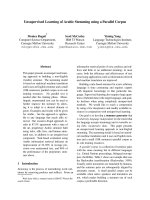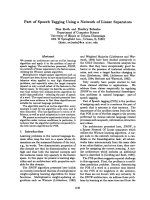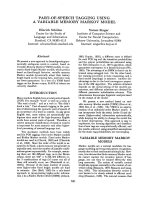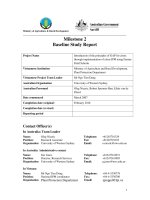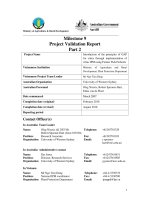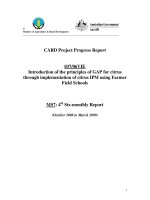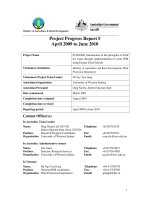IMPLEMENTATION OF MOBILE LEARNING USING A SOCIAL NETWORK PLATFORM: FACEBOOK
Bạn đang xem bản rút gọn của tài liệu. Xem và tải ngay bản đầy đủ của tài liệu tại đây (492.64 KB, 24 trang )
<span class="text_page_counter">Trang 1</span><div class="page_container" data-page="1">
<small>24</small>
IMPLEMENTATION OF MOBILE LEARNING USING A SOCIAL NETWORK PLATFORM: FACEBOOK
<b>John, G. Chaka, Irene Govender</b>
University of KwaZulu-Natal, South Africa E-mail: ,
<b>Abstract </b>
<i>This research set out to determine the use of a social networking platform, Facebook, as a medium for learning and teaching. Using a combination of the unified theory of acceptance and use of technology (UTAUT) model, Information Systems (IS) success model and the educational use of Facebook theory, a conceptual framework was developed for implementation of mobile learning and teaching. Structural equation modelling (SEM) was used to determine a model for the implementation of mobile learning and teaching. A sample of 330 respondents was used in this research. The data were analysed using structural equation modelling. The aim was to determine to what extent mobile learning is acceptable to colleges of education in Nigeria. Lecturers from a federal college of education in Nigeria were used to test the implementation of mobile learning using Facebook as a medium of communication. Four courses were selected as part of the intervention programme. The research revealed that m-learning significantly improves the teaching and learning conditions in colleges of education, specifically by reducing the inadequacies of physical facilities, and by improving the reading culture and performance of students. The results further indicate that most of the stakeholders are satisfied with the benefits of m-learning and wish to continue using the Facebook and their mobile phones.</i>
<b>Keywords: </b><i>educational system, quantitative approach, mobile learning, Facebook, SEM. </i>
<b>Introduction </b>
The United Nations Education, and Scientific Corporation – UNESCO (as cited in Otoo (2015)) has stated that Nigeria leads the world in terms of the number of people that have difficulty in accessing education. The inadequacy of the teaching and learning environments in most educational institutions especially at the tertiary level may have aggravated the situation. Most higher education institutions in the country lack the needed facilities, for example classrooms, books and other relevant educational materials (Asiyai, 2013; Ilogho, 2015; Jaja, 2013; Okojie, 2013). In addition, most Nigerian higher education institutions still depend on time-honoured teaching and learning methods, which are largely constrained by using the physical infrastructure such as classrooms, and libraries, which are not always suitable for teaching and learning. This makes it difficult for the Nigerian education institutions to cater to the increasing number of students who seek entrance to tertiary education, which gave impetus for this research.
Based on the positive results obtained from preliminary studies (Chaka & Govender, 2017a; Chaka & Govender, 2017b), which revealed that both lecturers and students were accepting the use of mobile devices to teach and learn, it became necessary to test the implementation of mobile learning to see how the acceptance and success measures work together. This research ascertains the viability and success of mobile learning in improving the teaching and learning
<i>conditions in Colleges of Education. Specifically, the Facebook application was used as the </i>
</div><span class="text_page_counter">Trang 2</span><div class="page_container" data-page="2"><small>Vol. 78, No. 1, 202025</small>
mobile learning medium. Most stakeholders in Colleges of Education have been using this application as ascertained from a preliminary study (Chaka, 2018). This research reports on part of a larger research study (Chaka, 2018).
<b>Literature Review</b>
<i>Related Literature</i>
Serbessa (2006, p. 129) described the time-honoured teaching method as the “chalk and talk” lecture approach where the students are passive recipients of knowledge. The teacher is at the centre of the teaching process using a rigid curriculum structure to teach all students in the same manner (Ahmed, 2013; Bishara, 2015).The problem with this approach is that access to education, depends on availability of physical infrastructure such as classrooms while learning depends on the teachers’ competence. Thus, Clark and Ausukuya (2013) reported that the insufficient number of teachers in most higher education institutions has resulted in teacher-student ratios as high as 1:356 in some cases, as against the recommended ratio of 1:25. This has affected not just the quality of training and performance of existing students, but also the enrolment of new students thereby increasing the access gap to education in the country. Klopfer, Osterweil, Groff and Haas (2009) argued that social networks have all the characteristics and potential of achieving good learning, as users are now creating, learning, and communicating in new ways. Thus, since time, lack of skills and lack of money constitute the major barriers to the use of conventional Virtual Learning Environment (VLEs) (Walker et al., 2014), the application of social networking sites in education seems to address these challenges. Corroborating this position, Selwyn (2012) stated that, perhaps the driving force behind the educational use of social networking sites is the nature of students that are enrolling in the institutions. Selwyn (2012, p. 2) further described the incoming students as those “who know nothing other than a life with the internet.”
In the light of the above, Alsereihy and Al Youbi (2014) have asserted that with the exponential increase in the popularity of social networking media, higher education institutions are beginning to embrace their applications for various educational purposes. They maintain that a number of Universities in the Western world today have included social networking sites as part of their platform to facilitate communication, research and collaboration among stakeholders. Thus, with the social interactive, communication and collaborative features of Social Networking Sites (SNS) which are lacking in most conventional learning management systems (LMSs), social networking sites are believed to be well-positioned to support teaching and learning (Buzzetto-More, 2012; Mazman & Usluel, 2010). They further argued that social networking sites, specifically Facebook, have the capacity to facilitate online discussions and collaboration among students, and between students and teachers, in addition to providing opportunities for the sharing of ideas, educational content as well as enhancement of communication among stakeholders. This is very important in light of the fact that the current generation of students are digital natives. This compels learning to be socially and digitally driven by ubiquitous technologies (Buzzetto-More, 2012). They maintain that since social networking sites are being used extensively by many people, their application to education is long overdue in view of the numerous advantages including learner-centred, collaboration, and active participation among others. They further stated that most people have a preference for communicating online instead of the traditional face-to-face approach. Yapici and Havedanli (2014), maintain that since most teachers and students are users of social networks, with Facebook having the largest population (e.g. 34% of Facebook users in Turkey are higher education students), the application of social networks in facilitating teaching and learning will certainly be rewarding. In this sense, Ahn (2011) argued that the youth of today
</div><span class="text_page_counter">Trang 3</span><div class="page_container" data-page="3"><small>Vol. 78, No. 1, 2020</small>
<small>26</small> communicate and learn more from outside the school premises. Thus, engaging in interactions using social networking sites is viewed as a form of literacy practice which contributes to learning. According to Adewole and Fakorede (2013), appropriation is a skill which enables the communication of ideas by remixing content from different sources. They posit that social networking sites provide the tools to enable students to gather, synthesize and remix content, thereby acquiring skills and knowledge. Similarly, Clark and Ausukuya (2013), stated that networking is the capacity to search, integrate, and disseminate information, which social networking sites provide.
In view of this, the next section examines the extent to which social networking sites have been useful in teaching and learning.
<i>Application of Social Networking in Teaching and Learning</i>
In what appears like the first stage of studies to establishing a link between the use of SNS and educational performance, Karpinski and Duberstein (2009) conducted a survey among students of Ohio Dominican University to ascertain if there was a link between the use of Facebook and educational performance. Although part of the findings of Karpinski and Duberstein (2009) indicated that Facebook users had lower performance than non-Facebook users, their study did not suggest that Facebook use led to lower performance, as there could be other factors such as personality traits. Building on this, Pasek, More, and Hargittai (2009) examined the association between social networking use and learning outcomes among undergraduate students, and they found that Facebook usage had no link with GPA. They therefore suggested further research to explore the association between Facebook and academic performance of students.
Laying a theoretical foundation on the application of SNS in education, Mazman and Usluel (2009) proposed a model for the educational use of social networking sites. Their model was conceived from previous innovation and technology acceptance models. Following this initial conception, Mazman and Usluel (2010) came up with a structural model to explain how users can use social networking sites specifically Facebook for educational purposes. The researchers tested out their model and found that user-purposes and adoption processes accounted for 50% of the variance in educational use of Facebook while Facebook adoption processes explained 86% of user purposes. In other words, while Facebook adoption processes alone accounted for 45% of variance in educational use of Facebook, the joined effects of Facebook adoption processes and user purposes accounted for 50% of the variance in education use of Facebook.
Additionally, in a bid to understand the efficacy of social networking sites as instructional tools, Buzzetto-More (2012) examined the perceptions of management students who have already completed courses. As part of his methodology, the researcher integrated Facebook use into some courses that were taken by management students for at least one academic semester. Facebook was used to create course groups for the courses involved and all students who had registered for the various courses were required to join. The findings from their study revealed that 33% of the participants indicated that they stay online for 3-8 hours per week engaged in social networking sites, and that 47% of them agreed that Facebook develops interpersonal relationships. In addition, Buzzetto-More (2012) found that social networking sites especially Facebook can strengthen relationships within learning communities as 47 per cent of the students agreed that Facebook can enhance their learning process. The report further reveals that 50% of the students see Facebook as a good tool to engage in learning. To further verify the use of SNS, Shembilu (2013) examined the benefits of social networking in education in Tanzania. The study found that the majority of the students (96%) use social networking sites to socialize with peers while a reasonable number (63%) use social networking sites
</div><span class="text_page_counter">Trang 4</span><div class="page_container" data-page="4"><small>Vol. 78, No. 1, 202027</small>
for sharing academic-related information. Shembilu (2013) also found out that Facebook was the most preferred social networking site while blogs ranked second. The study further revealed that 65% of the respondents feel that social networking sites can serve both social and academic needs of students. Regarding measures that needed to be put in place to facilitate the educational use of SNS, sensitization of students and educators was ranked first (87%) followed by provision of Internet access (68%), and distribution of Internet and ICT facilities nationwide (42%). Forcing government to provide free Internet centres was ranked last (12%). Shembilu (2013) concluded that although participants see the educational use of social networking sites as promising, and that there was some evidence of the educational use of SNS in Tanzania, not much sensitization had been done to widen the scope of usage. In addition, challenges of ICT infrastructure and cost of Internet bandwidth served as obstacles. Similarly, in order to assess the viability of SNS sites in facilitating teaching and learning, Dunn (2013) focused on the application of mobile and portable devices. Dunn (2013) found that the majority of students (92%) use one form of social networking medium or the other, with Facebook (86%) being the most popularly used. The study further indicated that 87% of subscribers use SNS for personal use, 33% for networking with other professionals while 24% use it for research-related activities. Regarding the belief of students in the helpfulness of social networking sites for learning, his study reveals that 75% of the students found social networking sites very helpful in learning. In a more recent study, Gülbahar (2014) found that students have positive perceptions on the use of social media in education but are, however not aware of the various facilitating tools that these technologies offer. A very recent study by Gorghiu, Iordache, Pribeanu, and Lamanauskas (2018) revealed that if students use Facebook for learning purposes, it is mainly for sharing learning material and collaboration.
Alsereihy and Al Youbi (2014) argued that the positive reports that are emanating from the western world on the usage and application of social networking sites in education cannot not be generalized to other countries. In the light of this, they examined the usage of social networking sites by higher education institutions in Saudi Arabia. Alsereihy and Al Youbi (2014) found among other things that the use of social networking applications was prevalent in major Universities in Saudi Arabia. They further found that Facebook was leading in terms of usage and awareness, but that the use of social networking sites as collaborating and educational tools was underutilized amidst privacy and security concerns.
Despite the promises of social networking sites and mobile learning in facilitating teaching and learning, no known study has integrated the use of mobile learning with social networking sites in Nigeria, especially in the context of Colleges of Education. Some studies (such as Adedoja et al., 2013; Osang & Ngole, 2014; Shaibu & Mike, 2014) have investigated mobile learning in Universities but not with social networking sites as the learning platform. The situation in other higher education institutions remains unclear in view of different affordances, which are key determinants of any research output (Traxler, 2007; Thomas et al., 2013). Colleges of Education are vital, based on their role as teacher training institutions, but are most affected in terms of the challenges that are confronting teaching and learning in Nigerian higher education institutions (Ogunyinka et al., 2015; Tella, 2011). Therefore, exploring the use of mobile learning in improving the teaching and learning conditions in higher education institutions, specifically Colleges of Education has become imperative. In view of the affordability and commonality of SNS, their use as the learning platform is considered.
Hence, this research was guided by the following research questions:
1. To what extent do the acceptance factors (performance expectancy, effort expectancy, social influence, mobile learning conditions, anxiety & personal innovativeness) jointly with user satisfaction influence the behavioural intention of participants to use Facebook as a medium to teach?
</div><span class="text_page_counter">Trang 5</span><div class="page_container" data-page="5"><b>Figure1 </b>
Conceptual framework of the research
<small>Performance Expectancy</small>
<small>Effort Expectancy</small>
<small>Social Influence</small>
<small>Mobile Learning Conditions</small>
<small>Personal Innovativeness</small>
<small>Communication & Interaction</small>
<small>Collaboration & Resource </small>
<small>Information QualitySystem Quality</small>
<small>centric Learning Behavioural </small>
<small>Actual Use of Mobile Learning</small>
<small>Improved Educational </small>
<small>Less Demand on Teacher</small>
<small>Less Demand on Physical </small>
<small>Improved Performance</small>
<small>Improved Reading Culture</small>
<small>User Satisfaction</small>
<small>Service Quality</small>
</div><span class="text_page_counter">Trang 6</span><div class="page_container" data-page="6"><small>Vol. 78, No. 1, 202029</small>
<b>Research Methodology</b>
<i>Research Approach and Design</i>
The quantitative approach followed the survey research strategy. This was to enable the possibility of generalizing the findings of the research to the entire population. The survey design was considered more feasible in this research in view of its advantages, most especially cost saving (Kumar, 2011). In addition, it was easier and advantageous to measure the attributes of a population from a smaller group (Creswell, 2014). This was imperative since Nigeria is one of the largest countries in Africa (landmass of 923,768 km²).
<i>Research Site</i>
The research was conducted in a College of Education in Nigeria, specifically in the North-central geopolitical zone of the country. This zone was selected in view of its cosmopolitan nature. Apart from being the zone where the nation’s capital (Abuja) is located, the zone is in the centre of the country and draws from the diverse cultures of almost all the ethnic groups in Nigeria.
<i>Intervention - Preparation of Lecturers for Implementation</i>
As part of the implementation process, the following guidelines were specifically provided to lecturers to follow:
1. Create a group in Facebook and name the group after the course that you are teaching (e.g. call the group DBE 221) if DBE 221 is the course to be taught;
2. Enrol your students as members of the group. Also add me (researcher) as a member of the group;
3. All activities should be performed using mobile devices (phones and possibly tablets) only.
4. Engage your students in various teaching and learning activities such as:
a. <i>Discussion forum: Post a question or topic that is relevant to the course and </i>
allow students to discuss it freely while the teacher facilitates.
<i>b. Sharing and collaboration: Encourage students to do more research into the </i>
topic and share relevant links with colleagues in the group. The teacher can also share relevant links, documents, files, videos, etc. in the groups.
c. <i>Assessment: Teachers can post assignment as a document or file to the group </i>
and advise students to submit the same through a private message to them.d. <i>Motivation: Teachers should encourage participation of students by awarding </i>
marks to very active participants and to quality contributors in the group.e. <i>Ubiquitous: since mobile devices are being used, participants should be </i>
engaged with the exercises at anytime and anywhere.
<i>Population and Sample</i>
Lecturers from a College of Education were used to test the use of mobile learning by using the technology to supplement the teaching of four selected courses (CS 412, DBE 221, GUC 205, SSE 313). One college was used to pilot the implementation of the use of social network site for effective management and monitoring of the exercise. Since the researcher was a member of staff, it was easy to gain access to the system as well as obtain the cooperation of the staff and students. Kumar (2011) posits that bias can be introduced by a researcher if it becomes difficult to penetrate the population.
</div><span class="text_page_counter">Trang 7</span><div class="page_container" data-page="7"><small>Vol. 78, No. 1, 2020</small>
<small>30</small> Four lecturers from four of the five schools in the college were part of the intervention. The schools included were School of Arts and Social Sciences, School of Education, School of Sciences, and School of Vocational and Technical Education. Based on Creswell’s (2014, p.93) list of ethical issues and possible ways of addressing them, this study adhered to the
<i>following ethical procedure: Permission was sought and granted from the National Commission for Colleges of Education (NCCE) - to undertake the study in Colleges of Education. A written </i>
approval was then granted by the College of Education. For all individuals that were involved in the study, their consent was obtained through a letter that was attached to the data collection instrument.
The researcher used his experience as an insider to select lecturers that were more knowledgeable in the use of computer and social networking applications. A social networking site (Facebook) was used as the teaching and learning platform. This is in view of the availability of the application, its user friendliness and compatibility with most mobile devices, and the fact that most members of the colleges were already using it. Based on Krejcie and Morgan’s (1970) table and Kumar’s (2011) suggestion, a study sample of 330 was considered adequate for the implementation of the research. A sample of 330 students was used in this study. The data were analysed using structural equation modelling.
<i>Data Collection Instruments</i>
The questionnaire used consisted of two sections – Section ‘1’ obtained demographic information while Section ‘2’ elicited information regarding the use of mobile learning in line with the constructs contained in the conceptual framework of the research. The items in the questionnaire were measured on a 5-point Likert scale ranging from 1 = strongly disagree to 5 = strongly agree. Different components of the questionnaire items were adapted from various sources. The first set of 26 items which measured the acceptance of mobile learning using a social networking site (Facebook) were adopted from Venkatesh et al., (2003) and Abu-Al-Aish and Love (2013). The second set of 48 items which measured the actual use and success of mobile learning were adopted from a number of sources (Alharbi & Drew, 2014;Delone & McLean, 2003; Lin et al., 2016). All the scales used in the research had good internal consistency reliability ratings, with most of them above .9.
<i>Data Analysis</i>
Categorical demographic variables were analysed or explored from different perspectives using cross-tabulations, while continuous variables were analysed using descriptive statistics including mean and standard deviation. Structural equation modelling (SEM) was used to test the fitness of the model to the data and to explore various relationships in the conceptual model in order to provide answers to the research questions. SEM was considered suitable to use in the implementation stage to enable the researcher test the conceptual framework which was a new conception (Kumar, 2011; Pallant, 2011).
A total number of 330 questionnaires were distributed to the respondents using the physical (face-to-face) method out of which 324 were retrieved. Three of the questionnaires were later discarded for inconsistency resulting in 321 useable questionnaires and a final response rate of 97%.
<b>Research Results</b>
<i>Descriptive Results</i>
The descriptive results emerged from the analysis of demographic information. Table 1 shows a cross-tabulation of stakeholders grouped by gender.
</div><span class="text_page_counter">Trang 8</span><div class="page_container" data-page="8"><small>Vol. 78, No. 1, 202031</small>
<b>Table 1</b>
Analysis of respondents by gender
Analysis of demographic information for continuous variables
<small>Use of mobile device </small>
<i><small>Valid N (listwise)</small></i> <small>321</small>
Table 2 shows that the minimum age of the respondents is 19 years while the maximum age is 52 years. The average age was 26.98. From the Table, it is gathered that the age of the respondents is positively skewed; meaning that majority of the respondents lie below the average age of 26.98. Table 2 further reveals that the respondents have used mobile devices for a minimum of one year and a maximum of 12 years.
<i>Quantitative Data Analysis Procedure Using SEM</i>
SEM using IBM Amos version 23 was used to analyse the data by exploring various relationships that exist in the proposed or conceptual framework. The primary goal of SEM is to determine and validate a proposed causal process or a model. In other words, the model used in the research was specified as the conceptual framework, subject to confirmation. We have a covariance matrix to serve as our dataset, which is based on the sample of collected measurements. The empirical question of SEM is therefore whether the proposed model produces a population covariance matrix that is consistent with the sample covariance matrix. Hence the model specified/proposed needs to be validated/ tested.
Therefore, using SEM is considered suitable to test the conceptual model, which is a new formulation. The interplay between different variables provides the answers to the research questions. In order to apply SEM, the data must satisfy a number of assumptions. Thus, as part of the process of analysis, the data in this study was first cleaned up and tested for the non-violation of the assumptions of SEM.
</div><span class="text_page_counter">Trang 9</span><div class="page_container" data-page="9"><small>Vol. 78, No. 1, 2020</small>
To conduct SEM, the data must meet two criteria, completeness and normality. There was no need to adopt any ad hoc measure since no missing data was present.
Normality was checked by looking at skewness and kurtosis for all variables in the model. The normality of the data on the dependent and/or mediating variables in the model (behavioural intention, and user satisfaction) were found to appear normal (skewness <=3 and Kurtosis <=10) (Pallant, 2011). This was done by assessing the effect of 5% trimmed mean on actual values. Skewness, and kurtosis of each measured (observable) dependable variable as shown in Table 3. The 5% trimmed mean refers to the computed mean excluding 5% of the upper (largest) and lower (smallest) values of the distribution.
</div><span class="text_page_counter">Trang 10</span><div class="page_container" data-page="10"><small>Vol. 78, No. 1, 202033</small>
<i>Sample Size</i>
Sample size is also an important factor in SEM. Although there may be no consensus regarding the sample size appropriate for SEM analysis (Sivo et al., as cited in (Hoe, 2008)), it is suggested that large samples of say 200 and above may result in the needed level of statistical power with any given model (Schreiber, Nora, Stage, Barlow, & King, 2006). Hence, the sample size of 321 utilized in this study is considered appropriate for applying SEM.
<i>Exploratory Factor Analysis and Validation of Measurement Model</i>
As part of the refinement process of the measurement model, exploratory factor analysis is used to assess the factor loadings of all items that estimate each construct. Due to the complexity of the conceptual model of the study, each of the 4 sub-models were taken individually and tested for ‘uni-dimentionality’ and cross-loading. Reliability and validity were calculated and, based on these results, adjustments were made. These adjustments included adding in covariance indicators to error variances and removing any measured items with low loadings or indications of cross-loading.
After the sub-models were treated individually and the ‘best’ sub-models achieved, they were taken together in pairs and then three at a time and the same process was carried out.Information regarding each construct in the measurement model with the number of factors entered and retained is presented in Table 4.
</div><span class="text_page_counter">Trang 11</span><div class="page_container" data-page="11"><small>Vol. 78, No. 1, 2020</small>
Information on various constructs in the measurement model
<b><small>ConstructInitial number of items</small><sup>Number of items retained</sup></b>
<i>Fitness of the Model</i>
To assess the fitness of the model, fit indices were used. Since it is not necessary or realistic to report all the fit indices produced by SEM application, Hooper et al., (2008) have
<i>recommended that, in addition to Chi-square value, its degree of freedom and the p-value, a </i>
variety of the indices which tests different aspects of the model fit should also be reported. In accordance with this discussion, this research reports at least one fit index from each test group. The chi-square value (CMIN or χ<small>2</small><i>), degree of freedom (df), chi-square value over degree of </i>
freedom (CMIN or χ<small>2</small><i> / df), RMSEA, GFI, IFI, TLI, and CFI were reported for each model test. </i>
For the integrated model proposed in this research, it was found that the best fit indices that could be obtained without dropping any of the constructs were not entirely within the prescribed values as can be seen in Table 5.
</div><span class="text_page_counter">Trang 12</span><div class="page_container" data-page="12"><small>Vol. 78, No. 1, 202035</small>
<b>Table 5</b>
Overall fit indices of the proposed measurement model
</div>

